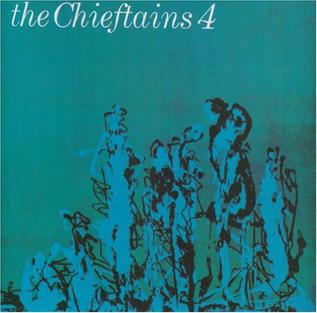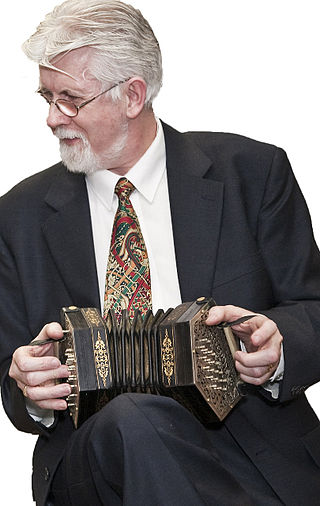
A concertina is a free-reed musical instrument, like the various accordions and the harmonica. It consists of expanding and contracting bellows, with buttons usually on both ends, unlike accordion buttons, which are on the front.

The English concertina is a member of the concertina family of free-reed musical instruments. Invented in England in 1829, it was the first instrument of what would become the concertina family.

The Irish flute is a conical-bore, simple-system, wooden flute of the type favoured by classical flautists of the early 19th century, or to a flute of modern manufacture derived from this design. The majority of traditional Irish flute players use a wooden, simple-system flute.

The Chieftains 4 is an album by The Chieftains. It is the first album to feature Derek Bell on the harp. This album is where The Chieftains' modern sound began.

Willie Clancy was an Irish uilleann piper, flute player and whistle player.
Breandán Breathnach was an Irish music collector and uilleann piper. In addition to collecting Irish music, he is known for his Ceol Rince na hÉireann series.
Johnny Doran was an Irish uilleann piper.

Patrick J. Killoran (1903–1965) was an Irish traditional fiddle player, bandleader and recording artist. He is regarded, along with James Morrison and Michael Coleman, as one of the finest exponents of the south Sligo fiddle style in the "golden age" of the ethnic recording industry of the 1920s and 1930s.
Michael "Mick" Tubridy is an Irish musician, step dancer and structural engineer.

Noel Hill is an Irish concertina player from County Clare who has had great influence developing the modern playing style of the Irish concertina, as a performer and educator.

Irish traditional music is a genre of folk music that developed in Ireland.

Patrick Joseph "Sonny" Brogan was an Irish accordion player from the 1930s to the 1960s, and was one of Ireland's most popular traditional musicians. He was one of the earliest advocates of the two-row B/C button accordion in traditional music, and popularised it the 1950s and 60s. He originally played on a single-keyed Hohner melodeon, and later the two-row Paolo Soprani (pictured) which he used until he died. Sonny's Paolo Soprani was one of the rarest, the grey model, made in 1948, when the company still made them by hand. Offaly-born button box player Paddy O'Brien currently has Sonny's accordion.
Bobby Gardiner is an Irish accordionist and lilter. He was recruited by Micheal O'Suilleabhain to the Music Department in University College Cork where he has been teaching traditional music for the last 25 years.
Junior Crehan was an Irish fiddle player who composed a number of tunes that remain popular within the Irish Traditional Music community.
Elizabeth Crotty, better known as Mrs. Crotty, was an Irish concertina player.
Ellen (Nell) Galvin was a fiddle and concertina player from County Clare, Ireland. She was originally from Ballydineen, Knockalough, near Kilmihil.

John J. Kimmel was a German-American musician known for playing Irish, Scottish, and American music on the 1-row diatonic accordion. Though not Irish-American, but rather German-American, Kimmel's playing had an enduring effect on the playing of the Irish accordion.

Gearóid Ó hAllmhuráin is an Irish ethnomusicologist, author, musician and historian specialising in Irish music, diaspora, cultural and memory studies.
John Hill Maccann, or Professor Maccann was a concertina player and designer from Plymouth, England. In 1884, Maccann patented a new design of Duet concertina, which became the first successful and most widely accepted layout of that instrument. Maccann's layout was a refinement of the earlier "Duette" system developed by Charles Wheatstone, inventor of the concertina. Initially called the "New Chromatic Duet English Concertina", it was to later be called simply the "Maccann system".
Liam O'Connor is an Irish fiddler, collector, researcher and teacher from County Dublin. He is the current director of the Irish Traditional Music Archive (ITMA). O'Connor has been described by The Journal of Music as "one of the outstanding fiddle-players of his generation".











